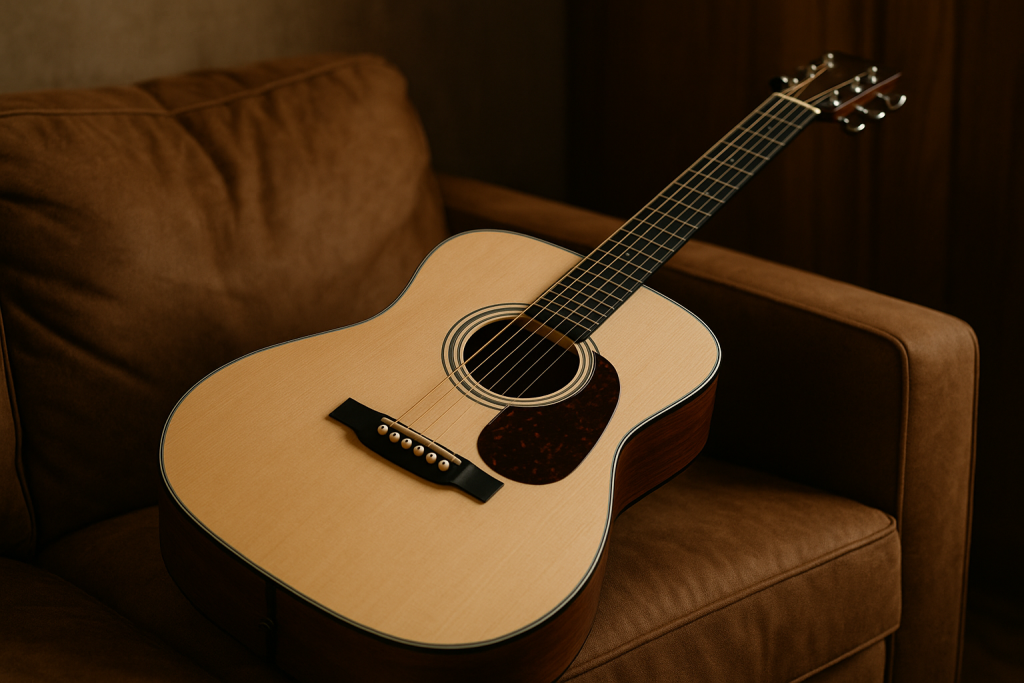There was a time when the acoustic guitar sat in the background, like the shy friend who carried the melody but never demanded credit. Then the world got loud. Electric guitars, synths, and overproduced pop tracks took over. But lately, the quiet hum of wood and steel has crept back in, and not just as nostalgia. Artists across genres are rediscovering the intimacy, imperfection, and texture that only an acoustic can offer. It’s a comeback that feels less like a revival and more like a course correction.
Part of what’s happening is that people are craving something real. With so much digital perfection around us, the acoustic guitar has become a symbol of truth again. Whether it’s indie artists recording on their porches or major pop acts releasing stripped-back versions of their hits, that unplugged sound cuts through. It’s honest, warm, and human. And it reminds listeners what emotion sounds like before it’s filtered and quantized into perfection.
Stripped Down, Tuned In
Streaming changed how we hear music. There’s no need to fill stadiums to find an audience anymore. You can reach millions from a spare bedroom. That shift made the acoustic guitar practical again. You don’t need an amp, a pedalboard, or a wall of gear. Just strings, a mic, and a story worth telling.
It’s also about accessibility. Acoustic guitars are portable, forgiving, and timeless. They meet players where they are. For someone learning their first chords, it’s not just a starter instrument. It’s a foundation. Every song begins somewhere simple, and an acoustic guitar has always been the truest way to hear whether a song actually works. Add to that the rise of online tutorials, social clips, and the growing culture of bedroom musicians, and you’ve got a generation of players who can make magic without a single plug-in. Some even spend more time picking through guitar picks than they do scrolling through presets.
The Folk Revival You Didn’t See Coming
Folk never really died. It just slipped into other genres and changed its outfit. Now, the folk influence is woven into everything from alt-country to R&B. Artists like Noah Kahan and Hozier brought poetic lyricism and acoustic storytelling to huge audiences. You’ll hear it in pop too, tucked into ballads and bridges that hinge on one clean guitar line.
There’s something grounding about those sounds. When the world feels noisy, the acoustic guitar becomes a form of meditation. You can strum away frustration or play softly into the night, letting those vibrations settle the noise inside your own head. It’s that kind of sincerity that listeners crave, whether they’re aware of it or not.
From Campfire to TikTok
Technology didn’t kill acoustic music. It gave it a new home. The campfire jam has turned into a viral clip. A single take on a phone can travel faster than a record deal ever could. When an artist plays unplugged online, people stop scrolling. There’s no visual overload, no overproduction, just the performer and the sound of fingertips against strings.
It’s also become part of the education loop for musicians. Learning to play like learning Spanish, starts with imitation, repetition, and rhythm. Acoustic guitars offer that same tactile connection between sound and effort. Every chord teaches patience, every strum becomes a sentence. And unlike other hobbies, it rewards emotion as much as skill.
The Return of the Handmade
There’s been a quiet movement toward craftsmanship in the guitar world. Players want instruments that feel alive in their hands, not just something off an assembly line. Smaller luthiers are getting attention again. Reclaimed wood, sustainable materials, and hand-shaped necks are becoming the new standard for those who care about tone as much as ethics.
Even mass-market brands have noticed the shift. The demand for acoustic guitars has surged over the past few years, especially during lockdowns. People didn’t just want to consume music. They wanted to create it. And nothing connects you to the sound more directly than a piece of wood resonating against your chest. It’s personal in a way electric never quite manages.
That connection doesn’t fade, either. A well-worn acoustic guitar ages like leather boots or a favorite jacket. Every nick, scratch, and shine tells a story. It becomes part of you, and that’s something no plugin can simulate.
Where Sound Meets Soul
What’s beautiful about this acoustic resurgence is that it’s not about rejecting the modern world. It’s about balance. The same artists who loop beats and layer vocals still reach for an acoustic when they want something pure. It’s not about going backward. It’s about grounding the future of music in its most human sound.
The acoustic guitar isn’t flashy. It doesn’t demand attention. It earns it. It thrives in honesty, imperfection, and connection, and that’s exactly what people are hungry for. Quietly, but unmistakably, the instrument that started it all has found its way back into the spotlight.
When you strip music down to its core, the acoustic guitar remains undefeated. It doesn’t need lights or distortion to make you feel something. It just needs a player willing to speak through strings. The world’s gotten louder, but the heart of music still beats in wood and wire. And maybe that’s the sound we were missing all along.

